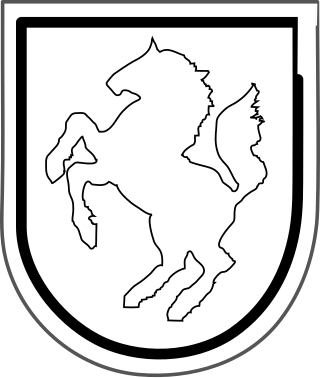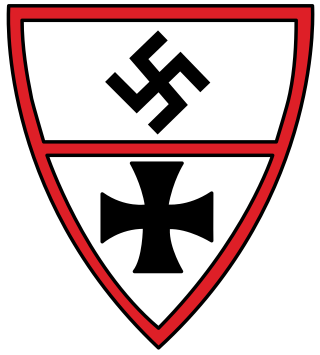| LV. Armeekorps | |
|---|---|
| Active | 6 January 1941 – 30 April 1945 |
| Country | |
| Branch | Army |
| Size | Corps |
| Engagements | World War II |
LV Army Corps (LV. Armeekorps) was a corps in the German Army during World War II.
| LV. Armeekorps | |
|---|---|
| Active | 6 January 1941 – 30 April 1945 |
| Country | |
| Branch | Army |
| Size | Corps |
| Engagements | World War II |
LV Army Corps (LV. Armeekorps) was a corps in the German Army during World War II.
The LV. Army Corps was created on 6 January 1941 in military district V (Stuttgart).
It participated in Operation Barbarossa as part of the 6th Army. It fought in the Battle of Brody (1941) and Battle of Kiev (1941). On 24 October 1941, it reached the city of Charkov of which commander General Vierow became governor. On December 27, the corps was hastily transferred to Maloarkhangelsk in the area northeast of Kursk, where the city of Liwny was lost on December 25 by a Soviet counteroffensive.
In 1942 the corps, now under the 2nd Army, was located in the region east of Maloarchangelsk in defensive/contention battles with the 13th Soviet Army (General Nikolai Pukhov) in the spring of 1942. In June 1942, the Corps advanced towards Liwny, but was halted and converted to trench warfare. In July 1942, the Corps as the left wing of the 2nd Army, was positioned on the border of Heeresgruppe Mitte and Heeresgruppe B and maintained the connection with the XXXV Army Corps of the 2nd Panzer Army.
In early 1943, the Corps was defeated in the Voronezh–Kastornoye operation and withdrew towards Oryol, where it suffered further defeats in Operation Kutuzov and the Battle of Smolensk. By the end of 1943, the Corps had withdrawn to Rahachow in Belarus, where the front stabilised. In 1944, the Corps suffered heavy casualties during the Bobruysk Offensive and Osovets Offensive as part of Operation Bagration. In January 1945, it fought against the Soviet East Prussian Offensive, ending the war defending the harbor city of Pillau.

The 13th Panzer Division was a unit of the German Army during World War II, established in 1940.
XXXXVIII Panzer Corps, was a corps-level formation of the German Army which saw extensive action on both the Eastern and Western Fronts during World War II.
The XXXIX Panzer Corps was a German panzer corps which saw action on the Western and Eastern Fronts during World War II.
The 18th Infantry Division was formed on 1 October 1934 as Infantry Command III in Liegnitz and renamed the 18th Infantry Division on 15 October 1935. Mobilized in August 1939, it participated in the Invasion of Poland and in 1940 in the Battle of France. After the French campaign, the division was motorized and redesignated 18th Motorized Infantry Division on 1 November 1940 serving on the Eastern Front for the remainder of the war. In June 1943, the division was redesignated 18th Panzergrenadier Division.

The Courland Pocket was an area of the Courland Peninsula where Army Group North of Nazi Germany and the Reichskommissariat Ostland were cut off and surrounded by the Red Army for almost a year, lasting from July 1944 until 10 May 1945.

The 15th Infantry Division was an infantry division of the German Army during the interwar period and World War II, active from 1934 to 1945.

V Army Corps was a corps in the German Army during World War II.

VIII Army Corps was a corps in the German Army during World War II. It was destroyed during the Battle of Stalingrad and reformed in mid-1943.
IX Army Corps was a corps in the German Army during World War II. It was formed on 1 October 1934 under the command of General Friedrich Dollman in Kassel with the camouflage name of Kassel and redesignated IX Corps after the creation of the Wehrkreis IX recruitment and training area.
German XX. Corps was a corps in the German Army during World War II.
German XIII. Corps was a corps in the German Army during World War II. It was destroyed during the Lvov–Sandomierz Offensive and reformed in late 1944.
X Army Corps was a corps in the German Army during World War II. It was formed in mid-May 1935 from the Cavalry Division.
XII Army Corps was a corps in the German Army during World War II. It was formed in the Wehrkreis XII recruitment and training district in Wiesbaden in October 1936 and was mobilized before the outbreak of war at the end of August 1939.
XIII Army Corps was a corps of the German Army during World War II. Made up of several divisions, which varied from time to time, it was formed in Nuremberg on 1 October 1937.
The XXIV Army Corps was a unit of the German Army during World War II. The unit was re-designated several times; originally being Generalkommando der Grenztruppen Saarpfalz, later Generalkommando XXIV. Armeekorps, then XXIV. Armeekorps (mot.) and finally XXIV. Panzerkorps.

XXXXII Army Corps was a corps in the German Army during World War II.
German XXXXIV. Corps was a corps in the German Army during World War II.
German XXXV. Corps was a corps in the German Army during World War II.
German XXXIV. Corps was a corps in the German Army during World War II, that was formed twice.

XXXXIII Army Corps was a corps in the German Army during World War II.